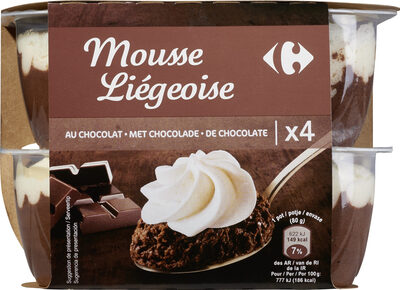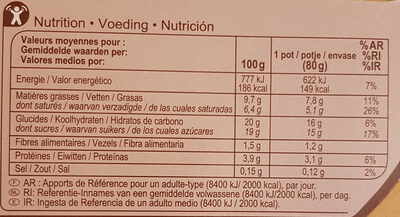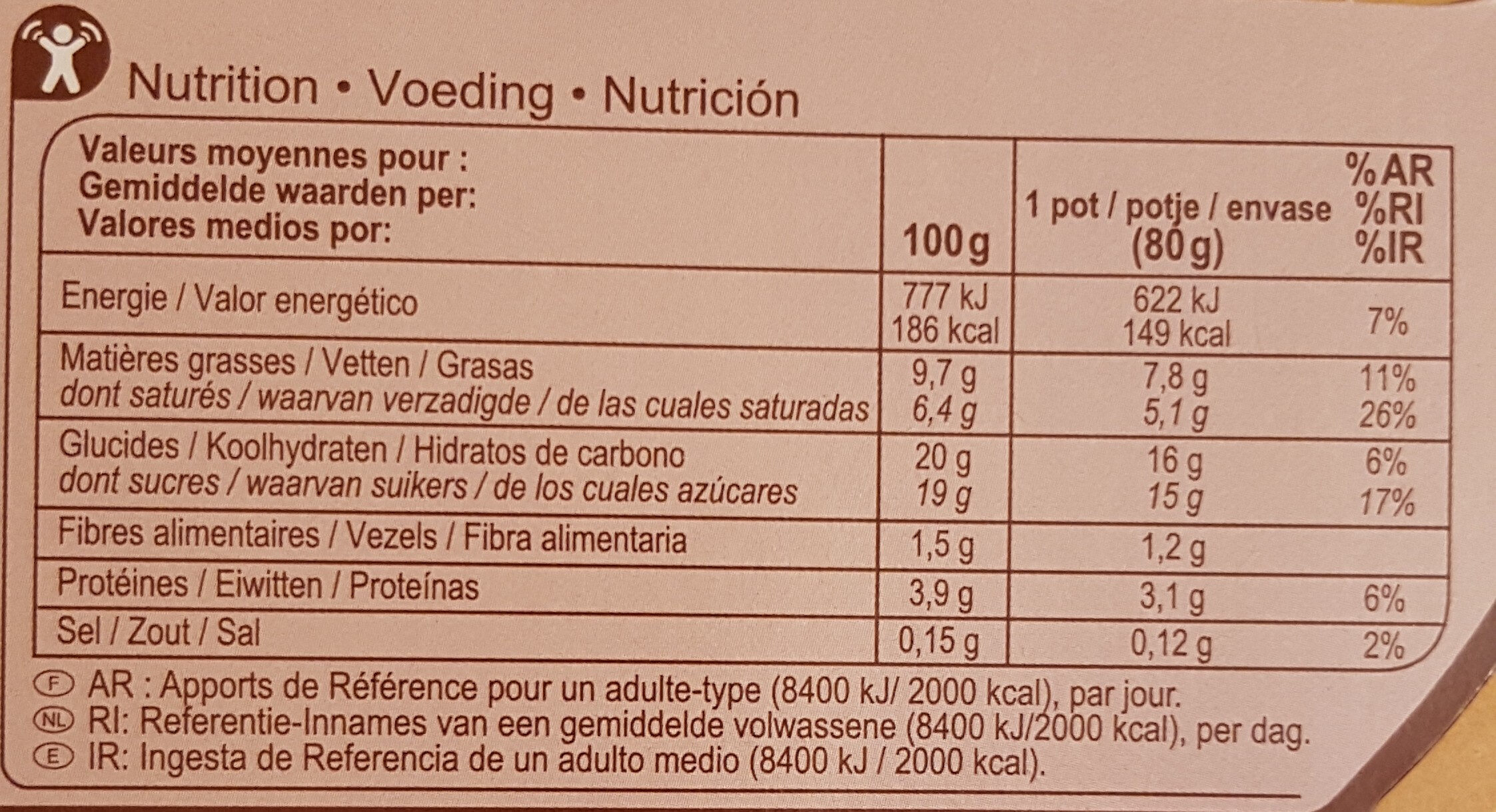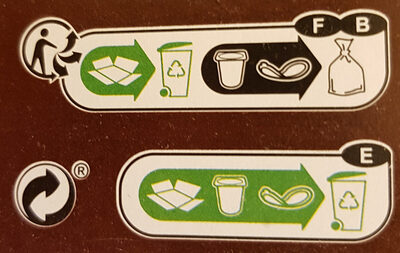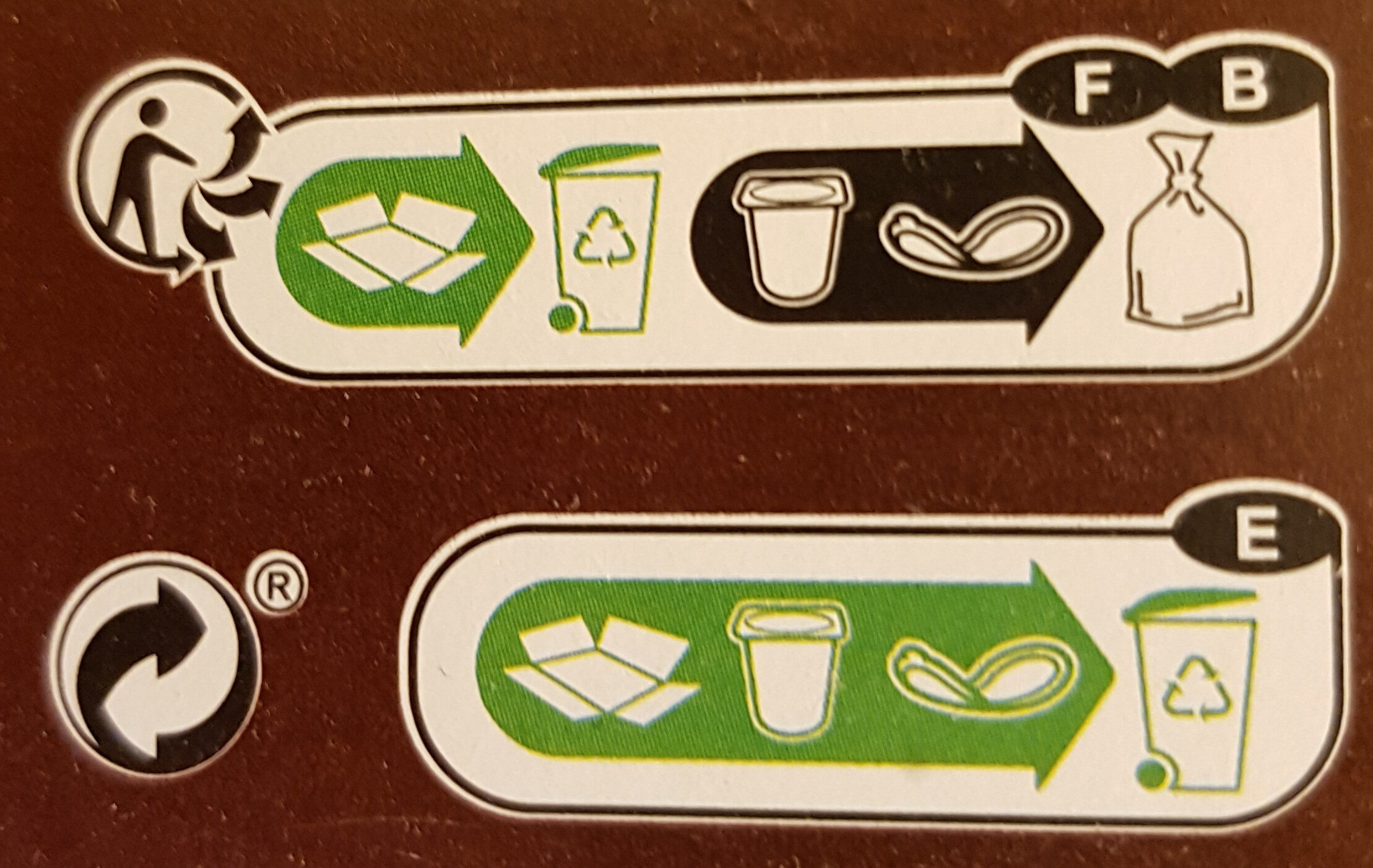Help us make food transparency the norm!
As a non-profit organization, we depend on your donations to continue informing consumers around the world about what they eat.
The food revolution starts with you!
Mousse liégeoise au chocolat - Carrefour - 320 g 2x(2 x 80 g) e
Mousse liégeoise au chocolat - Carrefour - 320 g 2x(2 x 80 g) e
Some of the data for this product has been provided directly by the manufacturer Carrefour.
Código de barras: 3270190216797 (EAN / EAN-13)
Common name: Dessert lacté au chocolat.
Cantidade: 320 g 2x(2 x 80 g) e
Empaquetado: en:Plastic, en:Pot, en:Cardboard, fr:Point vert, fr:Pot et opercule à jeter, fr:Étui carton à recycler
Marcas: Carrefour
Categorías: Produtos lácteos, en:Desserts, en:Dairy desserts, en:Chocolate desserts, en:Sweet mousses, en:Dairy Mousses, en:Chocolate mousses, en:Dairy chocolate desserts, en:Liégeois
Etiquetas, certificacións, premios:
en:French milk, en:Green Dot, en:Made in France, Triman

Orixe dos ingredientes: fr:Chocolat origine Afrique, fr:Crème origine France, fr:Lait origine France
Producer: Fabriqué en France par EMB 62853 pour Interdis.
Lugares de fabricación ou procesamento: France
Traceability code: FR 62.853.030 CE - Vieil-Moutier (Pas-de-Calais, France), EMB 62853 - Vieil-Moutier (Pas-de-Calais, France)
Tendas: Carrefour, carrefour.fr
Matching with your preferences
Health
Ingredientes
-
22 ingredients
: Lait entier 58,4%, crème fraîche 17,9%, sucre, chocolat noir 4,2% (pâte de cacao, sucre, cacao maigre en poudre, émulsifiant: lécithine de soja), cacao maigre en poudre, gélatine bovine, amidon modifié de pomme de terre, émulsifiant : esters lactiques des mono et diglycérides d'acides gras, arôme, épaississants : carraghénanes - gomme guar, sel, arôme naturel de vanille, protéines de lait, lactose et minéraux du laitAlérxenos: en:Milk, en:Soybeans
Food processing
-
Ultra processed foods
Elements that indicate the product is in the en:4 - Ultra processed food and drink products group:
- Aditivo: E14XX
- Aditivo: E322
- Aditivo: E407
- Aditivo: E412
- Aditivo: E428 - Xelatina
- Aditivo: Éster diacetil-láctico de mono- e diglicéridos de ácidos graxos
- Ingrediente: Emulsifier
- Ingrediente: Flavouring
- Ingrediente: Lactosa
- Ingrediente: Milk proteins
- Ingrediente: Thickener
Food products are classified into 4 groups according to their degree of processing:
- Unprocessed or minimally processed foods
- Processed culinary ingredients
- Processed foods
- Ultra processed foods
The determination of the group is based on the category of the product and on the ingredients it contains.
Aditivos
-
E322
Lecithin: Lecithin -UK: , US: , from the Greek lekithos, "egg yolk"- is a generic term to designate any group of yellow-brownish fatty substances occurring in animal and plant tissues, which are amphiphilic – they attract both water and fatty substances -and so are both hydrophilic and lipophilic-, and are used for smoothing food textures, dissolving powders -emulsifying-, homogenizing liquid mixtures, and repelling sticking materials.Lecithins are mixtures of glycerophospholipids including phosphatidylcholine, phosphatidylethanolamine, phosphatidylinositol, phosphatidylserine, and phosphatidic acid.Lecithin was first isolated in 1845 by the French chemist and pharmacist Theodore Gobley. In 1850, he named the phosphatidylcholine lécithine. Gobley originally isolated lecithin from egg yolk—λέκιθος lekithos is "egg yolk" in Ancient Greek—and established the complete chemical formula of phosphatidylcholine in 1874; in between, he had demonstrated the presence of lecithin in a variety of biological matters, including venous blood, in human lungs, bile, human brain tissue, fish eggs, fish roe, and chicken and sheep brain. Lecithin can easily be extracted chemically using solvents such as hexane, ethanol, acetone, petroleum ether, benzene, etc., or extraction can be done mechanically. It is usually available from sources such as soybeans, eggs, milk, marine sources, rapeseed, cottonseed, and sunflower. It has low solubility in water, but is an excellent emulsifier. In aqueous solution, its phospholipids can form either liposomes, bilayer sheets, micelles, or lamellar structures, depending on hydration and temperature. This results in a type of surfactant that usually is classified as amphipathic. Lecithin is sold as a food additive and dietary supplement. In cooking, it is sometimes used as an emulsifier and to prevent sticking, for example in nonstick cooking spray.Source: Wikipedia (Inglés)
-
E322i - Lecitina
Lecithin: Lecithin -UK: , US: , from the Greek lekithos, "egg yolk"- is a generic term to designate any group of yellow-brownish fatty substances occurring in animal and plant tissues, which are amphiphilic – they attract both water and fatty substances -and so are both hydrophilic and lipophilic-, and are used for smoothing food textures, dissolving powders -emulsifying-, homogenizing liquid mixtures, and repelling sticking materials.Lecithins are mixtures of glycerophospholipids including phosphatidylcholine, phosphatidylethanolamine, phosphatidylinositol, phosphatidylserine, and phosphatidic acid.Lecithin was first isolated in 1845 by the French chemist and pharmacist Theodore Gobley. In 1850, he named the phosphatidylcholine lécithine. Gobley originally isolated lecithin from egg yolk—λέκιθος lekithos is "egg yolk" in Ancient Greek—and established the complete chemical formula of phosphatidylcholine in 1874; in between, he had demonstrated the presence of lecithin in a variety of biological matters, including venous blood, in human lungs, bile, human brain tissue, fish eggs, fish roe, and chicken and sheep brain. Lecithin can easily be extracted chemically using solvents such as hexane, ethanol, acetone, petroleum ether, benzene, etc., or extraction can be done mechanically. It is usually available from sources such as soybeans, eggs, milk, marine sources, rapeseed, cottonseed, and sunflower. It has low solubility in water, but is an excellent emulsifier. In aqueous solution, its phospholipids can form either liposomes, bilayer sheets, micelles, or lamellar structures, depending on hydration and temperature. This results in a type of surfactant that usually is classified as amphipathic. Lecithin is sold as a food additive and dietary supplement. In cooking, it is sometimes used as an emulsifier and to prevent sticking, for example in nonstick cooking spray.Source: Wikipedia (Inglés)
-
E407
Carrageenan: Carrageenans or carrageenins - karr-ə-gee-nənz, from Irish carraigín, "little rock"- are a family of linear sulfated polysaccharides that are extracted from red edible seaweeds. They are widely used in the food industry, for their gelling, thickening, and stabilizing properties. Their main application is in dairy and meat products, due to their strong binding to food proteins. There are three main varieties of carrageenan, which differ in their degree of sulfation. Kappa-carrageenan has one sulfate group per disaccharide, iota-carrageenan has two, and lambda-carrageenan has three. Gelatinous extracts of the Chondrus crispus -Irish moss- seaweed have been used as food additives since approximately the fifteenth century. Carrageenan is a vegetarian and vegan alternative to gelatin in some applications or may be used to replace gelatin in confectionery.Source: Wikipedia (Inglés)
-
E412
Guar gum: Guar gum, also called guaran, is a galactomannan polysaccharide extracted from guar beans that has thickening and stabilizing properties useful in the food, feed and industrial applications. The guar seeds are mechanically dehusked, hydrated, milled and screened according to application. It is typically produced as a free-flowing, off-white powder.Source: Wikipedia (Inglés)
Análise dos ingredientes
-
en:May contain palm oil
Ingredients that may contain palm oil: Éster diacetil-láctico de mono- e diglicéridos de ácidos graxos
-
en:Non-vegan
Non-vegan ingredients: en:Whole milk, en:Fresh cream, en:Beef gelatin, en:Milk proteins, fr:Lactose et minéraux du lait
-
en:Non-vegetarian
Non-vegetarian ingredients: en:Beef gelatin
-
Details of the analysis of the ingredients
: _Lait_ entier 58.4%, _crème_ fraîche 17.9%, sucre, chocolat noir 4.2% (pâte de cacao, sucre, cacao maigre en poudre, émulsifiant (lécithine de _soja_)), cacao maigre en poudre, gélatine bovine, amidon modifié de pomme de terre, émulsifiant (esters lactiques des mono- et diglycérides d'acides gras), arôme, épaississants (carraghénanes), gomme guar, sel, arôme naturel de vanille, protéines de _lait_, _lactose_ et minéraux du _lait_- _Lait_ entier -> en:whole-milk - vegan: no - vegetarian: yes - ciqual_food_code: 19023 - percent_min: 58.4 - percent: 58.4 - percent_max: 58.4
- _crème_ fraîche -> en:fresh-cream - vegan: no - vegetarian: yes - ciqual_food_code: 19402 - percent_min: 17.9 - percent: 17.9 - percent_max: 17.9
- sucre -> en:sugar - vegan: yes - vegetarian: yes - ciqual_proxy_food_code: 31016 - percent_min: 4.2 - percent_max: 17.9
- chocolat noir -> en:dark-chocolate - vegan: maybe - vegetarian: yes - ciqual_proxy_food_code: 31074 - percent_min: 4.2 - percent: 4.2 - percent_max: 4.2
- pâte de cacao -> en:cocoa-paste - vegan: yes - vegetarian: yes - ciqual_proxy_food_code: 16030 - percent_min: 1.05 - percent_max: 4.2
- sucre -> en:sugar - vegan: yes - vegetarian: yes - ciqual_proxy_food_code: 31016 - percent_min: 0 - percent_max: 2.1
- cacao maigre en poudre -> en:fat-reduced-cocoa-powder - vegan: yes - vegetarian: yes - ciqual_food_code: 18100 - percent_min: 0 - percent_max: 1.4
- émulsifiant -> en:emulsifier - percent_min: 0 - percent_max: 1.05
- lécithine de _soja_ -> en:soya-lecithin - vegan: yes - vegetarian: yes - ciqual_food_code: 42200 - percent_min: 0 - percent_max: 1.05
- cacao maigre en poudre -> en:fat-reduced-cocoa-powder - vegan: yes - vegetarian: yes - ciqual_food_code: 18100 - percent_min: 0.145454545454546 - percent_max: 4.2
- gélatine bovine -> en:beef-gelatin - vegan: no - vegetarian: no - percent_min: 0 - percent_max: 4.2
- amidon modifié de pomme de terre -> en:modified-potato-starch - vegan: yes - vegetarian: yes - ciqual_proxy_food_code: 9510 - percent_min: 0 - percent_max: 3.87090909090909
- émulsifiant -> en:emulsifier - percent_min: 0 - percent_max: 3.22575757575758
- esters lactiques des mono- et diglycérides d'acides gras -> en:e472b - vegan: maybe - vegetarian: maybe - from_palm_oil: maybe - percent_min: 0 - percent_max: 3.22575757575758
- arôme -> en:flavouring - vegan: maybe - vegetarian: maybe - percent_min: 0 - percent_max: 2.76493506493507
- épaississants -> en:thickener - percent_min: 0 - percent_max: 2.41931818181818
- carraghénanes -> en:e407 - vegan: yes - vegetarian: yes - percent_min: 0 - percent_max: 2.41931818181818
- gomme guar -> en:e412 - vegan: yes - vegetarian: yes - percent_min: 0 - percent_max: 2.15050505050505
- sel -> en:salt - vegan: yes - vegetarian: yes - ciqual_food_code: 11058 - percent_min: 0 - percent_max: 0.15
- arôme naturel de vanille -> en:natural-vanilla-flavouring - vegan: yes - vegetarian: yes - percent_min: 0 - percent_max: 0.15
- protéines de _lait_ -> en:milk-proteins - vegan: no - vegetarian: yes - percent_min: 0 - percent_max: 0.15
- _lactose_ et minéraux du _lait_ -> fr:lactose-et-mineraux-du-lait - vegan: no - vegetarian: yes - percent_min: 0 - percent_max: 0.15
en:milk -> en:milk
Nutrición
-
Poor nutritional quality
⚠ ️Warning: the amount of fruits, vegetables and nuts is not specified on the label, it was estimated from the list of ingredients: 0This product is not considered a beverage for the calculation of the Nutri-Score.
Positive points: 1
- Proteínas: 2 / 5 (valor: 3.9, rounded value: 3.9)
- Fiber: 1 / 5 (valor: 1.5, rounded value: 1.5)
- Fruits, vegetables, nuts, and colza/walnut/olive oils: 0 / 5 (valor: 0, rounded value: 0)
Negative points: 12
- Enerxía: 2 / 10 (valor: 777, rounded value: 777)
- Azucres: 4 / 10 (valor: 19, rounded value: 19)
- Saturated fat: 6 / 10 (valor: 6.4, rounded value: 6.4)
- Sodio: 0 / 10 (valor: 60, rounded value: 60)
The points for proteins are not counted because the negative points are greater or equal to 11.
Nutritional score: (12 - 1)
Nutri-Score:
-
Nutrient levels
-
Greix in moderate quantity (9.7%)
What you need to know- A high consumption of fat, especially saturated fats, can raise cholesterol, which increases the risk of heart diseases.
Recommendation: Limit the consumption of fat and saturated fat- Choose products with lower fat and saturated fat content.
-
Saturated fat in high quantity (6.4%)
What you need to know- A high consumption of fat, especially saturated fats, can raise cholesterol, which increases the risk of heart diseases.
Recommendation: Limit the consumption of fat and saturated fat- Choose products with lower fat and saturated fat content.
-
Azucre in high quantity (19%)
What you need to know- A high consumption of sugar can cause weight gain and tooth decay. It also augments the risk of type 2 diabetes and cardio-vascular diseases.
Recommendation: Limit the consumption of sugar and sugary drinks- Sugary drinks (such as sodas, fruit beverages, and fruit juices and nectars) should be limited as much as possible (no more than 1 glass a day).
- Choose products with lower sugar content and reduce the consumption of products with added sugars.
-
Sal común in low quantity (0.15%)
What you need to know- A high consumption of salt (or sodium) can cause raised blood pressure, which can increase the risk of heart disease and stroke.
- Many people who have high blood pressure do not know it, as there are often no symptoms.
- Most people consume too much salt (on average 9 to 12 grams per day), around twice the recommended maximum level of intake.
Recommendation: Limit the consumption of salt and salted food- Reduce the quantity of salt used when cooking, and don't salt again at the table.
- Limit the consumption of salty snacks and choose products with lower salt content.
-
-
Información nutricional
Información nutricional As sold
for 100 g / 100 mlAs sold
por ración (80g)Compared to: en:Chocolate mousses Enerxía 777 kj
(186 kcal)622 kj
(149 kcal)+38% Greix 9,7 g 7,76 g +125% Saturated fat 6,4 g 5,12 g +118% Carbohydrates 20 g 16 g +25% Azucre 19 g 15,2 g +38% Fiber 1,5 g 1,2 g Proteína 3,9 g 3,12 g -40% Sal común 0,15 g 0,12 g -21% Fruits‚ vegetables‚ nuts and rapeseed‚ walnut and olive oils (estimate from ingredients list analysis) 0 % 0 %
Medio ambiente
-
Eco-Score B - Low environmental impact
The Eco-Score is an experimental score that summarizes the environmental impacts of food products.→ The Eco-Score was initially developped for France and it is being extended to other European countries. The Eco-Score formula is subject to change as it is regularly improved to make it more precise and better suited to each country.Life cycle analysis
-
Average impact of products of the same category: B (Score: 73/100)
Categoría: Custard topped with whipped cream (chocolate, coffee, caramel or vanilla custard), refrigerated
Categoría: Custard topped with whipped cream (chocolate, coffee, caramel or vanilla custard), refrigerated
- PEF environmental score: 0.33 (the lower the score, the lower the impact)
- including impact on climate change: 4.63 kg CO2 eq/kg of product
Stage Impact Agriculture
32.7 %Processing
53.2 %Empaquetado
4.8 %Transportation
5.8 %Distribution
2.8 %Consumption
0.8 %
Bonuses and maluses
-
Origins of ingredients with a medium impact
Bonus: +3
Environmental policy: 0
Transportation: +3
Origin of the product and/or its ingredients % of ingredients Impact Francia 58 %Medium Unknown 42 %High
-
Packaging with a medium impact
Malus: -12
Shape Material Recycling Impact Seal Plastic Discard High Sleeve Cardboard Recycle Low Pot Unknown High ⚠ ️ The information about the packaging of this product is not sufficiently precise (exact shapes and materials of all components of the packaging).⚠ ️ For a more precise calculation of the Eco-Score, you can modify the product page and add them.
If you are the manufacturer of this product, you can send us the information with our free platform for producers.
Eco-Score for this product
-
Carbon footprint
-
Equal to driving 2.4 km in a petrol car
463 g CO² per 100g of product
The carbon emission figure comes from ADEME's Agribalyse database, for the category: Custard topped with whipped cream (chocolate, coffee, caramel or vanilla custard), refrigerated (Source: ADEME Agribalyse Database)
Stage Impact Agriculture
23.8 %Processing
66.2 %Empaquetado
4.0 %Transportation
5.0 %Distribution
0.8 %Consumption
0.1 %
Empaquetado
-
Packaging with a medium impact
-
Packaging parts
Sleeve (Cardboard)
Seal (Plastic)
Pot
-
Packaging materials
Material % Packaging weight Packaging weight per 100 g of product Paper or cardboard Plastic Total
-
Transportation
-
Origins of ingredients
Origins of ingredients with a medium impact
Origin of the product and/or its ingredients % of ingredients Impact Francia 58 %Medium Unknown 42 %High
Other information
Other information: Estos 4 envases no pueden venderse por separado. x4 320g 2x(2x80g)e Con nata
Conservation conditions: A consommer jusqu'au : voir la date indiquée sur le dessus de l'emballage. A conserver entre +1°C et +8°C.
Customer service: Interdis - TSA 91431 - 91343 MASSY Cedex - France
Report a problem
-
Incomplete or incorrect information?
Category, labels, ingredients, allergens, nutritional information, photos etc.
If the information does not match the information on the packaging, please complete or correct it. Open Food Facts is a collaborative database, and every contribution is useful for all.
Data sources
Product added on by openfoodfacts-contributors
Last edit of product page on by inf.
Páxina do produto tamén editada por aleene, carrefour, date-limite-app, driveoff, ecoscore-impact-estimator, feat, fgouget, kiliweb, moon-rabbit, org-carrefour, packbot, roboto-app, sebleouf, segundo, teolemon.
